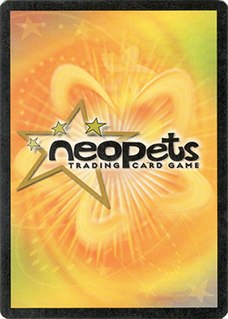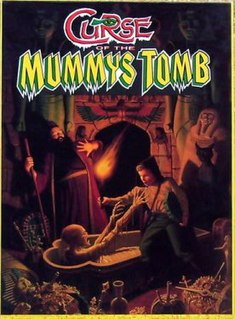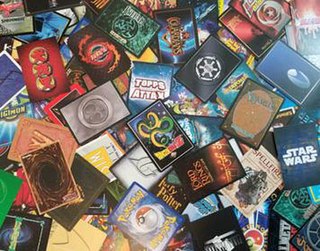Related Research Articles

Magic: The Gathering is a tabletop and digital collectible card game created by Richard Garfield. Released in 1993 by Wizards of the Coast, Magic was the first trading card game and had approximately thirty-five million players as of December 2018, and over twenty billion Magic cards were produced in the period from 2008 to 2016, during which time it grew in popularity.

Kill Doctor Lucky is a humorous board game designed by James Ernest and released in 1996 by Cheapass Games. In 1998, Kill Doctor Lucky won the Origins Award for Best Abstract Board Game of 1997.
Vampire: The Eternal Struggle is a multiplayer collectible card game published by White Wolf Publishing. It is set in the World of Darkness and is based on the Vampire: The Masquerade roleplaying game.

Vs. System, also written as VS System and abbreviated as VS, is a collectible card game designed by Upper Deck Entertainment (UDE). In the game, players build and play a deck of Vs. System cards in an attempt to win a game against their opponent. It was first published in 2004 and is set in the superhero genre. The game was discontinued by Upper Deck Entertainment in January 2009.

The 'Neopets TCG' is a collectible card game and a spin-off of the popular virtual pet website, Neopets. The game was launched in 2003 and produced by Wizards of the Coast, a large trading card company that produces a variety of other trading card games. Neopets is aimed at a slightly younger audience than other Wizards of the Coast offerings such as Magic: The Gathering. As with many other trading card games, the cards serve two purposes, collecting and playing a game.
Zombies!!! is a tile-based strategy board game for two to six players. Zombies!!! won the 2001 Origins Award for Best Graphic Presentation of a Board Game, and Zombies!!! 3: Mall Walkers won 2003's Origins Award for Best Board Game Expansion.
A Game of Thrones is a strategy board game created by Christian T. Petersen and published by Fantasy Flight Games in 2003. The game is based on the A Song of Ice and Fire series of high fantasy novels by George R. R. Martin. It was followed in 2004 by the expansion A Clash of Kings, and in 2006 by the expansion A Storm of Swords.

Power Grid is the English-language edition of the multiplayer German-style board game Funkenschlag designed by Friedemann Friese and first published in 2004. Power Grid is published by Rio Grande Games.

Phantasy Star Online Episode III: C.A.R.D. Revolution is a turn-based role-playing video game released for the GameCube in 2003. It has a card-based play style, making it unique among games in the Phantasy Star Online series. The story of the game takes place twenty-one years after the first two episodes.

Dark Millennium is an out-of-print collectible card game. It's the successor to the Horus Heresy and set in the fictional Warhammer 40,000 universe. The base card set was launched in October 2005 by Sabertooth Games.

Twilight Imperium is a strategy board game produced by Fantasy Flight Games. It was designed by Christian T. Petersen and was first released in 1997. The game is in its fourth edition (2017), which has large changes over previous editions. It is known for the length of its gameplay, and its in-depth strategy.
StarCraft: The Board Game, published by Fantasy Flight Games, is a game inspired by the 1998 computer game StarCraft. Players take control of the three distinctive races featured in the video games, the Terrans, the Protoss, or the Zerg, to engage in battle across multiple worlds in order to achieve victory. Each of the three races features a fairly different playing style. A prototype of the game was shown in BlizzCon 2007, with pre-release copies sold at Gen Con 2007 and Penny Arcade Expo 2007. It was publicly released in October 2007.
Magic: The Gathering formats are various ways in which the Magic: The Gathering collectible card game can be played. Each format provides rules for deck construction and gameplay, with many confining the pool of permitted cards to those released in a specified group of Magic card sets. The Wizards Play Network, the governing body that oversees official Magic competitive play, categorizes its tournament formats into Constructed and Limited. Additionally, there are many casual formats with the Commander format being one of the most popular formats of the game.
The Catan Card Game, originally named The Settlers of Catan: The Card Game, is a card-game adaptation of The Settlers of Catan board game. It is a member of the Catan series of games developed by Klaus Teuber and published by Kosmos in German, and by Mayfair Games in English. The Catan Card Game is a two-player game, although the rules can be accommodated as to allow players to share a set or for each player to have their own, as is intended for tournament play. Seven expansions of the Catan Card Game have also been released.
Card advantage is a term used in collectible card game strategy to describe the state of one player having access to more cards than another player, usually by drawing more cards through in-game effects to increase the size of their hand. Although it applies to several collectible card games, the concept was first described early in the evolution of Magic: The Gathering strategy, where many early decks relied on a player drawing more cards than their opponent, and then using this advantage to play more cards and advance their position faster than their opponent. By 2007 it was recognized as one of the most important indicators of who is ahead in a game and has been utilized in the development of strategy for nearly every collectible card game created.

Chaotic is an out-of-print Danish collectible card game brought to the United States by Chaotic USA and 4Kids Entertainment, and distributed by TC Digital Games. It was released along with the open beta version of the online game on October 24, 2007. The card game is also featured in the animated series of the same name. As of 2014, the website is currently closed and the cards are no longer in production.

Curse of the Mummy's Tomb is a pulp fiction board game published by Games Workshop in 1988. It features a three-dimensional board, representing an Egyptian pyramid, with two consecutively smaller playing areas above the bottom board. The aim of the game is to reach the top of the Pyramid of Khonsu, complete the tasks within and obtain the Elixir of Life. In addition to traps, creatures and treasures, there can be encounters with the deadly Mummy itself.
Killer Bunnies and the Journey to Jupiter is a board game with a non-collectible card game element created by Jeff Bellinger and published by Playroom Entertainment. It is the sequel game to Killer Bunnies and the Quest for the Magic Carrot.

A collectible card game (CCG), also called a trading card game (TCG) among other names, is a type of card game that mixes strategic deck building elements with features of trading cards, introduced with Magic: The Gathering in 1993.

Galaxy Trucker is a science-fiction board game for two to four players. The game was developed by Vlaada Chvatil, with graphics designed by Radim Pech. The Czech version of the game was released in 2007 by Czech Games Edition, and a German version was published in the same year by Heidelberger Spieleverlag. In 2021, revised edition of this game was released.
References
- ↑ "Vanished_Planet_Tutorial". Wayback Machine. Archived from the original on 5 October 2013. Retrieved 22 September 2021.
- ↑ "Games Magazine Awards: 2005". funagain.com. Funagain Games. Archived from the original on 18 February 2019. Retrieved 6 August 2021.
- ↑ "2005 Buyer's Guide To Games". Games. Vol. 28, no. 206. GAMES Publications. December 2004. pp. 33–48.
- ↑ "Pyramid: Pyramid Review: Vanished Planet".